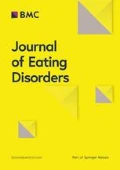Aim
To investigate through Structural Equation Modelling (SEM), the relationship between parenting styles, teasing about body weight/shape or eating, internalization of the thin ideal and body dissatisfaction amongst eating disorders (EDs) and controls and to see whether the risk factor model differed across various European countries and ED subtypes.
Method
The total sample comprised 1373 participants(ED patients=618).The Cross-Cultural Questionnaire (CCQ) was used to assess the above-mentioned risk factors.
Results
SEM analyses showed that the best fitting model was one allowing risk paths to vary across countries [χ2(425)=2105.271,p<.0001,RMSEA,=.022,CFI=.980]. In all countries teasing about weight/shape or eating was associated with body dissatisfaction(directly and via internalization of the thin ideal).There was a strong significant path from body dissatisfaction to ED(standardised path coefficient across countries:0.44-0.69, p<0.0001).Teasing about weight/shape or eating also directly predicted EDs (in the UK, Spain and Slovenia).There was however a weak effect of parenting on both teasing about weight/shape or eating and EDs directly.Risk models slightly varied across ED diagnoses.
Conclusion
Our hypothesised model was partially confirmed; in particular the central role of teasing on EDs both directly and mediated by internalization of the thin ideal and body dissatisfaction was shown across five European countries.Conversely, the effect of parenting varied by country and therefore might have cross-cultural effects.
This abstract was presented in the Prevention & Public Health stream of the 2014 ANZAED Conference.
Author information
Authors and Affiliations
Corresponding author
Rights and permissions
This article is published under an open access license. Please check the 'Copyright Information' section either on this page or in the PDF for details of this license and what re-use is permitted. If your intended use exceeds what is permitted by the license or if you are unable to locate the licence and re-use information, please contact the Rights and Permissions team.
About this article
Cite this article
Krug, I., Fuller-Tyszkiewicz, M., Mitchell, S. et al. A psychosocial risk factor model for female eating disorders: a European multicentre project. J Eat Disord 2 (Suppl 1), O39 (2014). https://doi.org/10.1186/2050-2974-2-S1-O39
Published:
DOI: https://doi.org/10.1186/2050-2974-2-S1-O39

